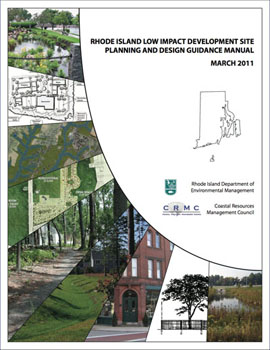
RI Coastal Resources Management Council
...to preserve, protect, develop, and restore coastal resources for all Rhode Islanders

...to preserve, protect, develop, and restore coastal resources for all Rhode Islanders
DEM, CRMC announce completion of RI Low Impact Site Planning and Design Guidance Manual
Contact: Gail Mastrati 222-4700 ext. 2402
 March 29, 2011, PROVIDENCE – The Department of Environmental Management and the Coastal Resources Management Council announce the completion of the Rhode Island Low Impact Development Site Planning and Design Guidance Manual (LID manual). This new low impact development (LID) manual is a companion guide to the recently revised Rhode Island Stormwater Design and Installation Standards Manual (stormwater manual).
March 29, 2011, PROVIDENCE – The Department of Environmental Management and the Coastal Resources Management Council announce the completion of the Rhode Island Low Impact Development Site Planning and Design Guidance Manual (LID manual). This new low impact development (LID) manual is a companion guide to the recently revised Rhode Island Stormwater Design and Installation Standards Manual (stormwater manual).
The LID manualwas specifically developed to provide local planning officials with guidance and examples of how their ordinances can be amended to avoid and reduce stormwater impacts from new development or redevelopment, and encourage effective implementation of LID practices. The recommended site-planning and design techniques can help preserve community character, reduce flooding impacts, and save costs for municipal operation and maintenance. “This new guidance tool for low impact development was developed to assist our community partners accommodate desirable growth without sacrificing the environment or the quality of life that Rhode Islanders enjoy,” noted DEM Director Janet Coit. “The new LID manual provides excellent examples and guidance to assist local decision-makers in making minor adjustments to existing ordinances to meet the goals of avoiding and reducing impacts to our public waters,” said Grover Fugate, Executive Director of CRMC.
In the past, stormwater management was primarily an engineering exercise to collect and dispose of runoff as quickly as possible. The new Rhode Island Stormwater Design and Installation Standards Manual, however, changes stormwater management to encourage or require more creative site-planning and design, as well as better engineering and maintenance practices in keeping with the requirements of the Smart Development for a Cleaner Bay Act of 2007.
The new stormwater manual requires LID practices for all major development, representing a fundamental shift in how development projects are planned and designed. LID is a more comprehensive and effective approach to managing stormwater that uses site-planning and design techniques that store, infiltrate, evaporate, and detain runoff as close as possible to the point where precipitation reaches the ground.
LID can be used to accommodate growth and reduce the environmental impact of site development. Many of the LID concepts employ non-structural onsite treatment that can reduce the cost of infrastructure while maintaining or even increasing the value of the property relative to conventionally-designed developments. In the past the landscape was altered significantly to fit the conventional style of development, whereas the LID process is reversed such that the development is designed to fit the landscape and its natural features.